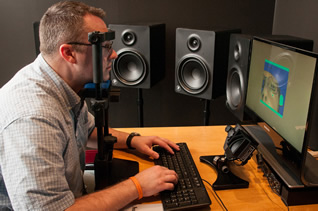

| ||||||
| HOME | RESEARCH | PUBLICATIONS | PARTICIPATE IN AN EXPERIMENT | JOIN THE LAB | ||
|
||
| Our research mainly utilises three methods, either by themselves or combined. 1) Behavioural experiments 2) Eye tracking 3) Transcranial magnetic stimulation (TMS) |
||
Behavioural experiments In a typical behavioural experiment, participants sit in front of a computer screen and they are presented with visual or auditory stimuli, or sometimes both at the same time. Participants would be required to respond to the stimuli usually by pressing computer keys as instructed by the experimenter. Most of time we ask participants to judge or detect a stimulus as quickly and accurately as possible. Measuring their behaviour by recording judgment accuracy or reaction time allows us to draw conclusions about how the brain processes information. |
||
Eye tracking Another way we measure people's behaviour is recording their eye movements. Where people look and how they move their eyes can inform us about how people think. Usually eye tracking is used on participants as they perform some behavioural task. Eye tracking can be finicky business because even the best eye trackers don't tolerate movements of the head very well. For that reason, participants in an eye tracking experiment are required to keep their heads resting on a chin rest and remain as still as possible throughout the experiment. |
||
Transcranial magnetic stimulation (TMS) TMS is a safe and noninvasive brain mapping technique that involves using magnetic fields to change brain activity and then measuring changes in behaviour or cognitive performance that this causes. TMS therefore allows researchers to directly assess the causal relationship between brain and behaviour. Our lab is equipped with the biphasic MagStim Rapid2 TMS machine, capable of single pulse and repetitive TMS. |
||
 |
||
| The Neurocognition and Psychophysics Laboratory, Department of Psychology, University of Saskatchewan | ||